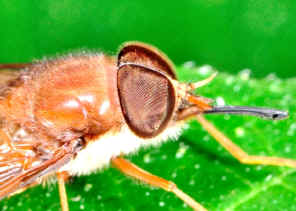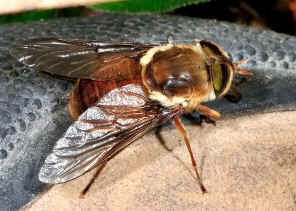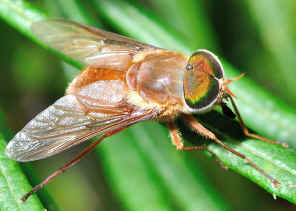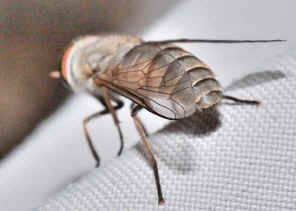March Flies, Horse Flies - Family Tabanidae
Order Diptera
This page contains pictures and information about March Flies that we found in the Brisbane area, Queensland, Australia. They are also known as Horse Flies.

- Body length 10mm
- March Flies have stout body and they are from small to large in size. They are usually grey to brown in colours, a few are colourful. They have large eyes with reflective iridescent colour. The antenna are segmented flagellum. Their mouth is the strong straight proboscis for piercing and sucking. Their wings always have the 'Y' shaped veins at the tip. Usually there are the dense short hairs on their body.
-



- Proboscis for piercing and sucking
- Adult March Flies feed on nectar. Most species of females require blood meal to produce eggs. They target on horse, cattle and humans.
- March Fly larvae of most species live in fresh water, damp soil or rotting plants. The larvae are carnivorous, preying on insects and snails.
Subfamily Chrysopsinae
- - Ocelli fully developed,
- - Antennal flagellum usually with a basal plate and 4-annulate.
- We did not found any species in this group yet.
Slender March Flies - Subfamily Pangoniinae, Pangoniini
- - Ocelli fully developed,
- - Antennal flagellum usually 8-annulate,
- - eyes usually bare,
- - R4 with appendix,
- Slender March Fly



- Ectenopsis (Ectenopsis) sp., body length 12mm
- Ectenopsis is slender fly. Its eyes are bare and there are eight annulate 3rd antennal segment. The separation between eyes is wide and ocellus are well developed. Proboscis is stout and long, about the same length as head height. On wings vein R4 has strong appendix. Please check this page for more information.
Subfamily Pangoniinae, Scionini
- - Ocelli fully developed,
- - Antennal flagellum usually 8-annulate,
- - eyes usually hairy,
- - R4 usually without appendix,
- Flower-feeding March Fly



- Scaptia (Scaptia) auriflua, female, male, body length 10mm,
- Most other female March Flies are blood sucker but this fly is flower feeder. Both male and female feed on nectars. The fly covered with dense hair mimicking bee. They will buzz like a bee to try to scare you away. Picture taken in Yugarapul Park during early summer. They are common along Bulimba Creek in Wishart area. Note the piercing mouthparts in front of the eyes. For more information and pictures please visit this page.
- Greyish-Brown March Fly



- Scaptia (Scaptia) testacea, female, male, body length 10mm
- This March Fly is uniform brown in colour. Antenna and all legs are brown. The abdomen is golden brown. Eyes are hairy, ocelli are fully developed. Please check this page for more information.
- Banded-wing March Fly



- Scaptia (Pseudoscione) concolor, female, male, body length 10mm
- This March Fly is uniform brown in colour. Antenna and all legs are brown. The abdomen is golden brown. Eyes are hairy, ocelli are fully developed. Please check this page for more information.
Robust March Fly - Subfamily Tabaninae, Tabanini
- - Ocelli rudimentary or absent,
- - Frons with a callus,
- - Antennal flagellum usually with a basal plate and 4-annulate,
- - On wings R5 and M3 cells always open,
- - On wings, basicosta with dense setulate, as setulate on sc,
- Australian Common March Fly



- Tabanus australicus, body length 15mm
- This March Fly is common in Brisbane bushes.. March Flies are sometimes known as Green Heads. This March Fly landed on our body a few time. Some species of female feed on blood and targeting human. This fly might not do any good to us. We always drove them away as soon as possible. Please also check this page for more information.
- - Ocelli rudimentary or absent,
- - Antennal flagellum usually with a basal plate and 4-annulate,
- - On wings R5 and M3 cells always open,
- - On wings, basicosta without setulate,
- - Proboscis relatively stout with large labella,
- Yellowish-brown March Fly



- Cydistomyia avida, body length 15mm
- This is a medium-sized March Fly with greyish brown scutum and yellowish brown abdomen. Eyes are reddish brown in colour with green reflection. This is a common species in Brisbane. Please check this page for more information.
- Reddish-brown March Fly
-



- Cydistomyia fergusoni, body length 12mm
- This is a medium size reddish-brown March Fly. Eyes are reddish brown without hairs. Antennae is relatively slender. Thorax is brown with greyish hue. All legs are brown. Wings are Uniformly pale greyish with veins in brown colour. Abdomen is cinnamon brown, with dark brown to black hairs. Please check this page for more information.
- Brown March Fly



- Dasybasis sp.
- This is a medium size brown March Fly. The eyes are reddish-brown. This March Fly has eyes with short hairs. On wings there is strong appendix with R4. Please check this page for more information.
- Unknown March Fly I





- Reference:
- 1. Insects of Australia - CSIRO, Division of Entomology, Melbourne University Press, 2nd Edition 1991, p754.
- 2. Insects of Australia and New Zealand - R. J. Tillyard, Angus & Robertson, Ltd, Sydney, 1926, p358.
- 3. Northern Territory Insects, A Comprehensive Guide CD - Graham Brown, 2009.
- 4. Family TABANIDAE - Australian Biological Resources Study, Australian Faunal Directory.
- 5. On the Fly, The Interactive Atlas and Key to Australian Fly Families CD Rom - Hamilton, J. et al. 2006. Brisbane : CBIT & ABRS.
- 6. Tabanidae (Horse, March Flies) - Insects of Tasmania: Diptera.
- 7. Revision of the horse fly genera Lissimas and Cydistomyia (Diptera: Tabanidae: Diachlorini) of Australia - Mackerras, I.M., Spratt, D.M. & Yeates, D.K. 2008, Zootaxa 1886: 1-80.
- 8. The Tabanidae (Diptera) of Australia I. General - Mackerras, I.M., 1956, Australian Journal of Zoology, 4: 376-407.
9. The Tabanidae (Diptera) of Australia II. Subfamily Pangoninae, tribe Pangoniini - Mackerras, I.M., 1956, Australian Journal of Zoology, 4: 408-443.
10. The Tabanidae (Diptera) of Australia III. Subfamily Pangoninae, tribe Scionini and supplement to Pangoniini - Mackerras, I.M., 1960, Australian Journal of Zoology, 8: 1-152.
11. The Tabanidae (Diptera) of Australia IV. Subfamily Chrysopinae - Mackerras, I.M., 1961, Australian Journal of Zoology, 9: 827-906.
12. The Tabanidae (Diptera) of Australia V. Subfamily Tabanini, tribe Tabanini - Mackerras, I.M., 1971, Australian Journal of Zoology, Supplementary Series, 4: 54 pp.
